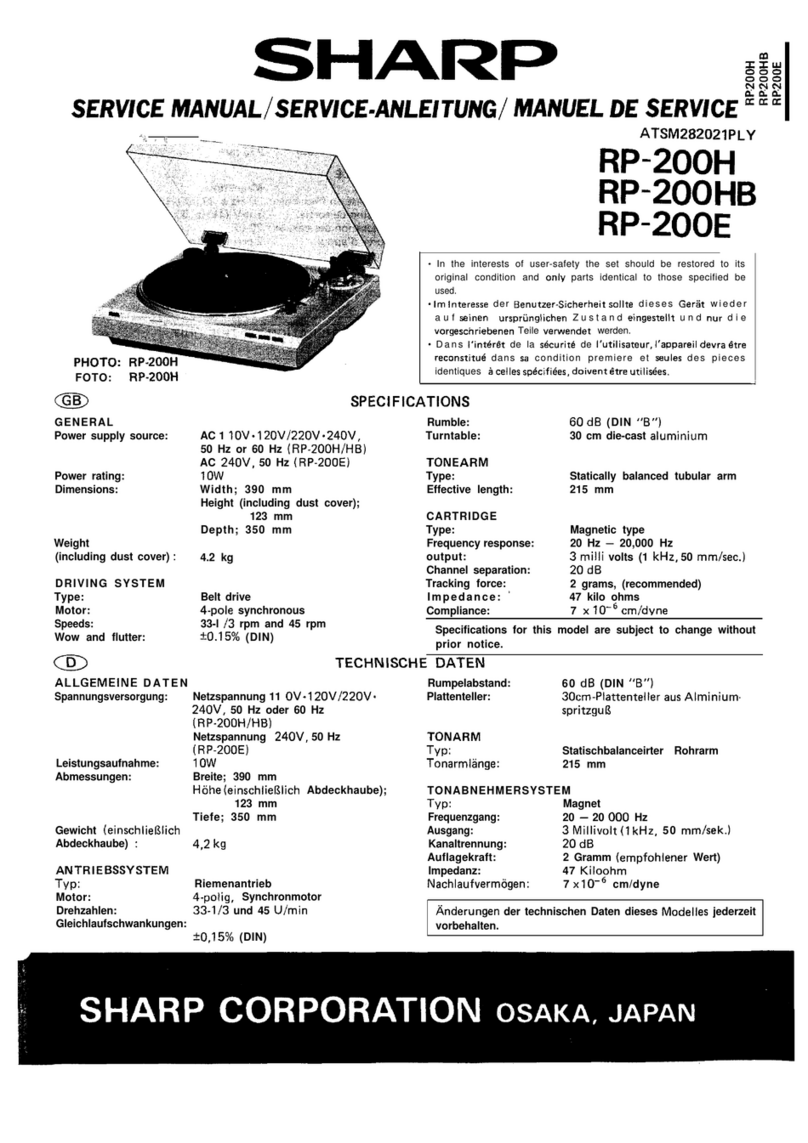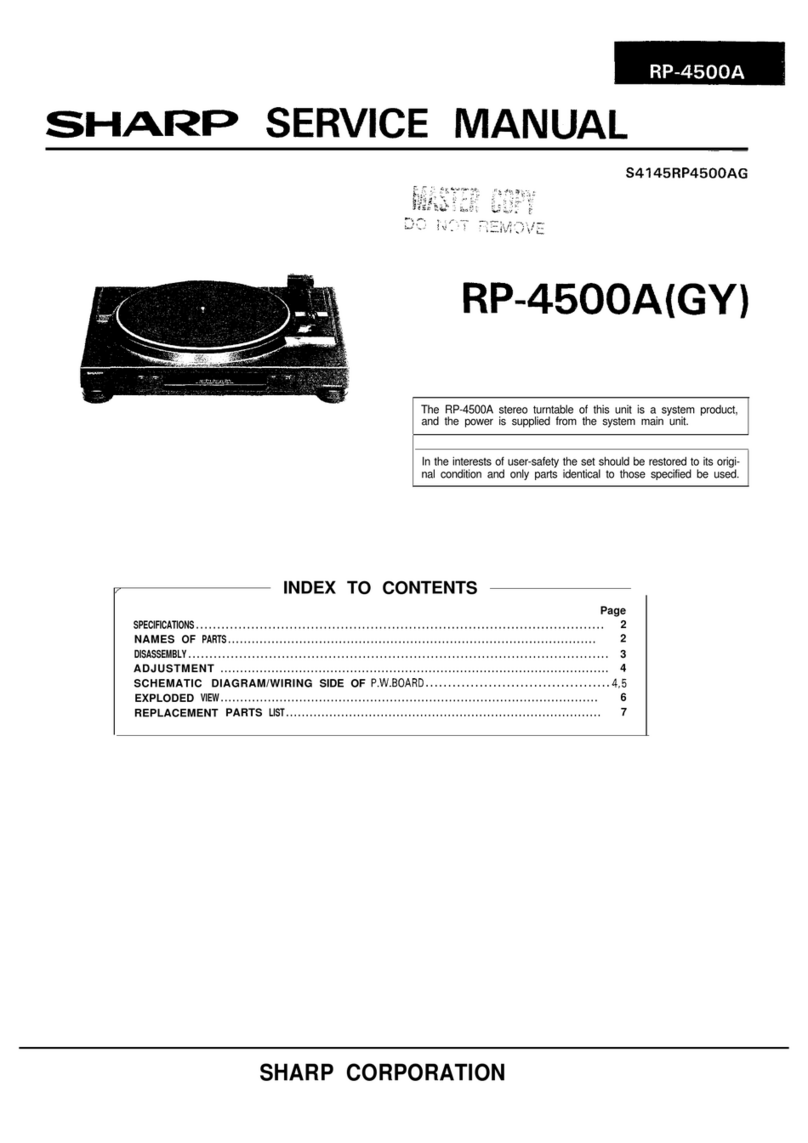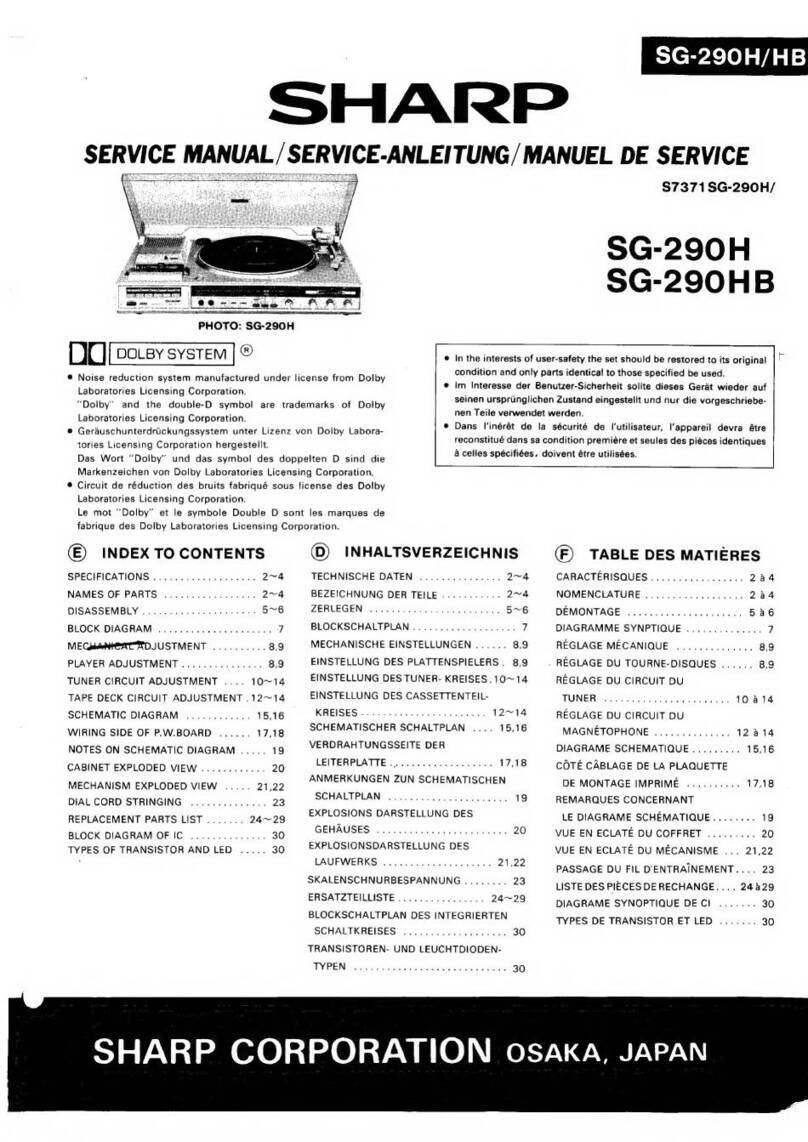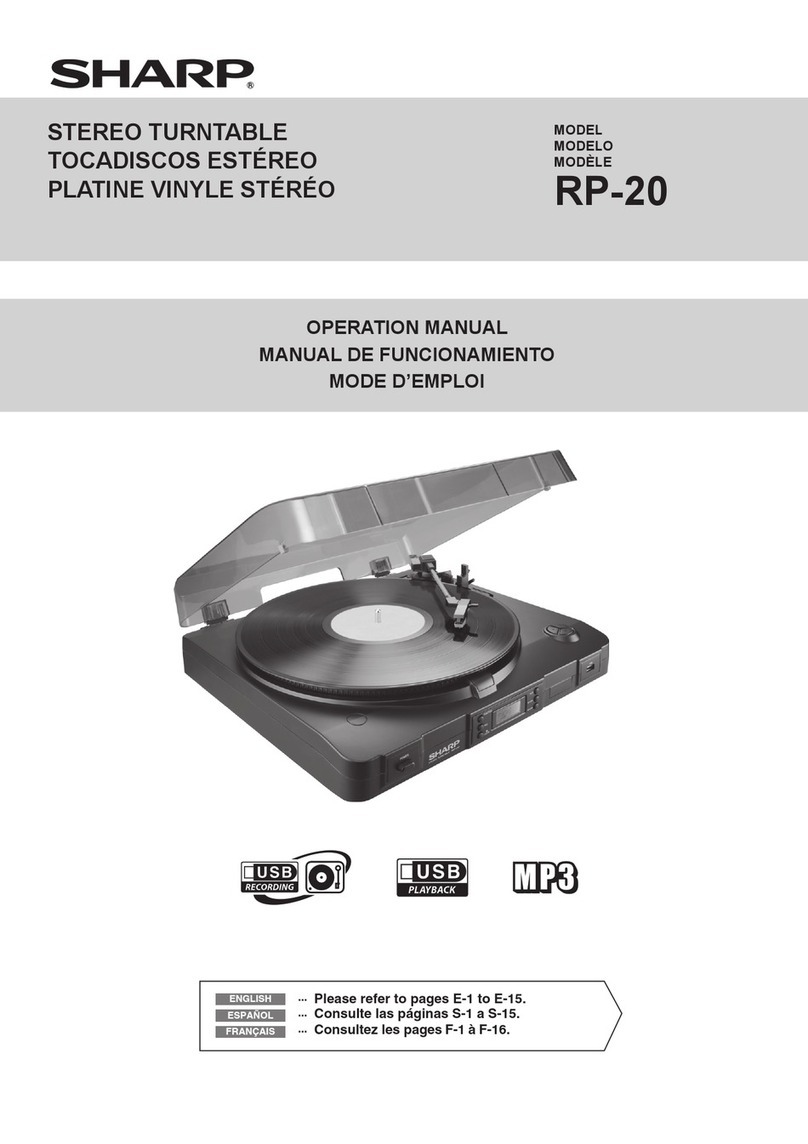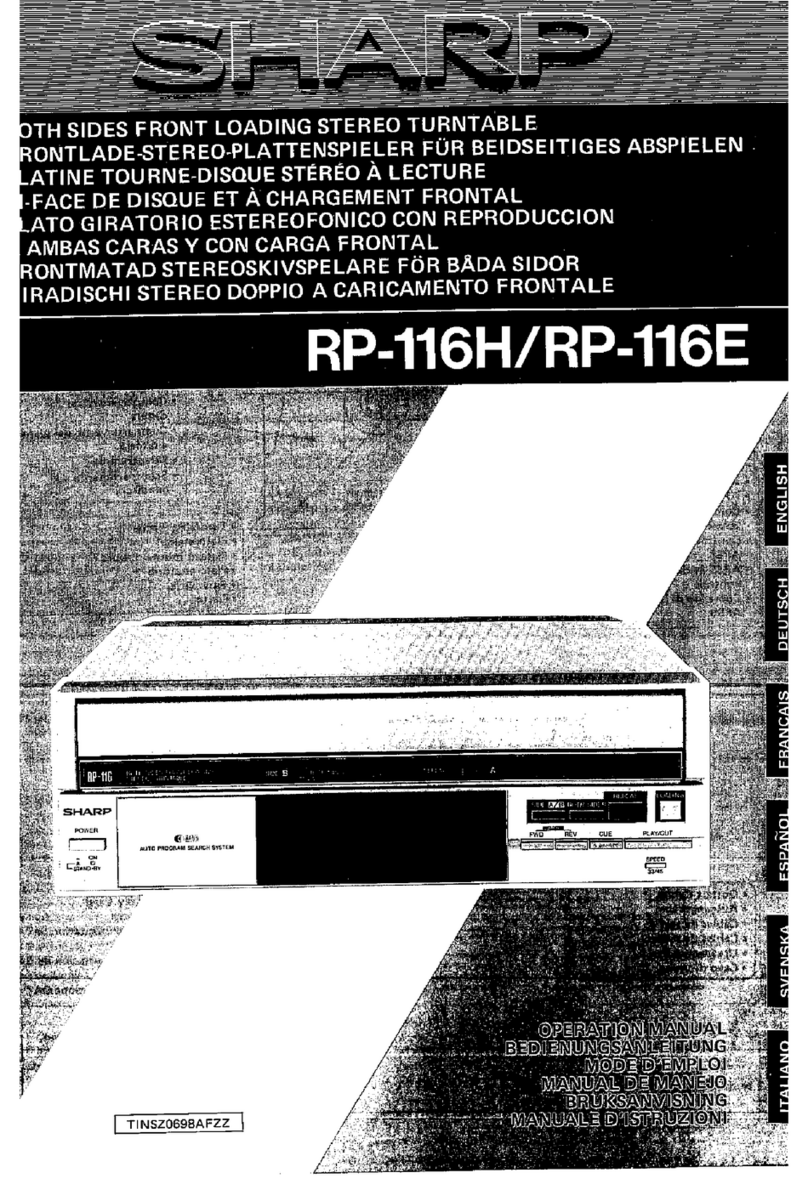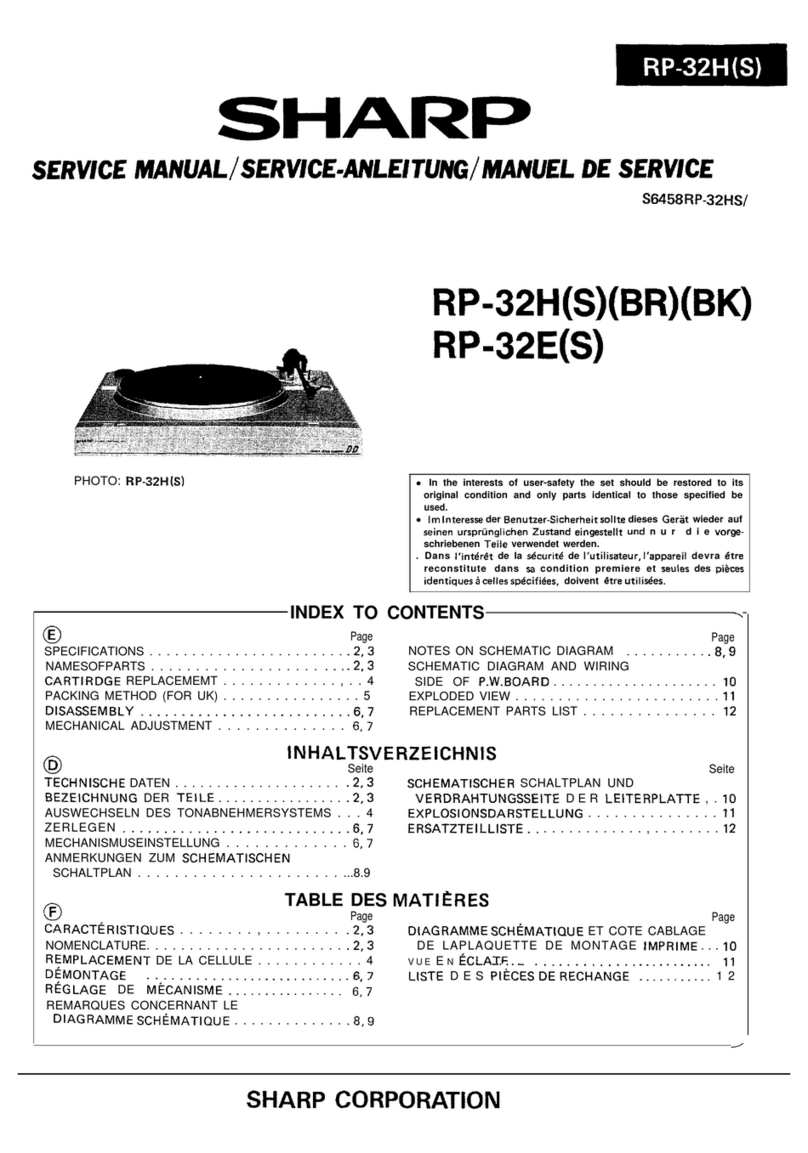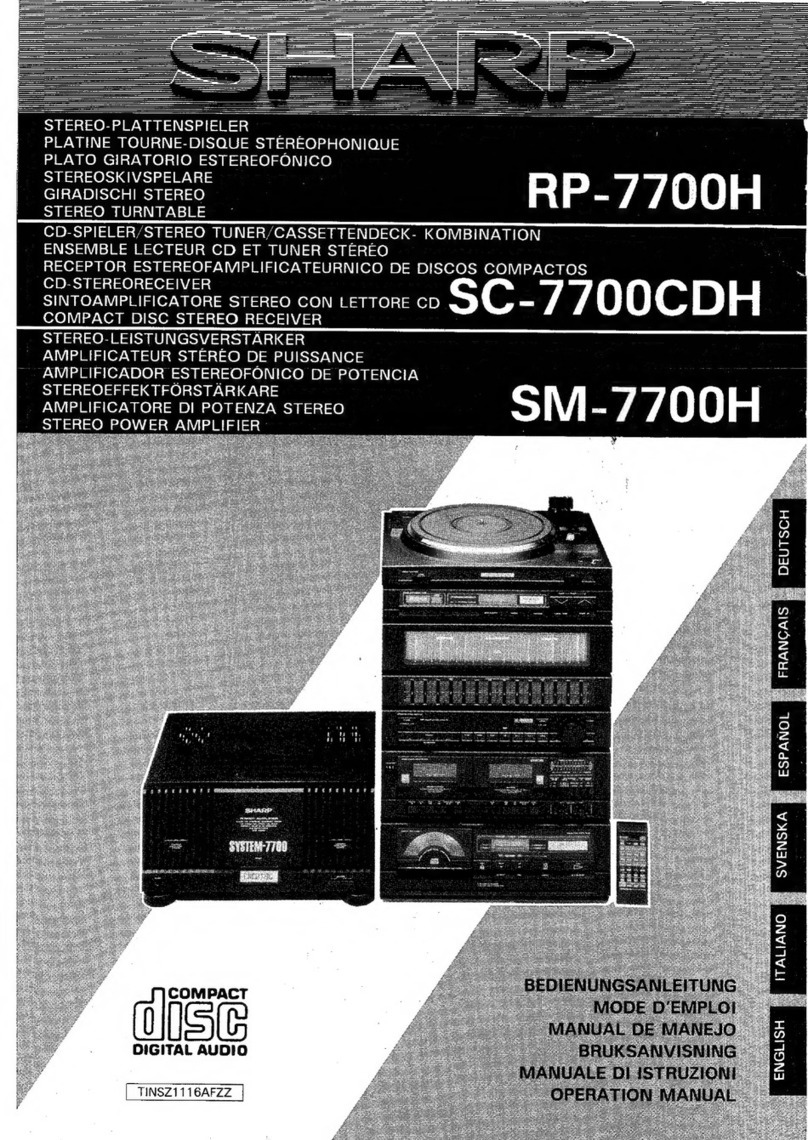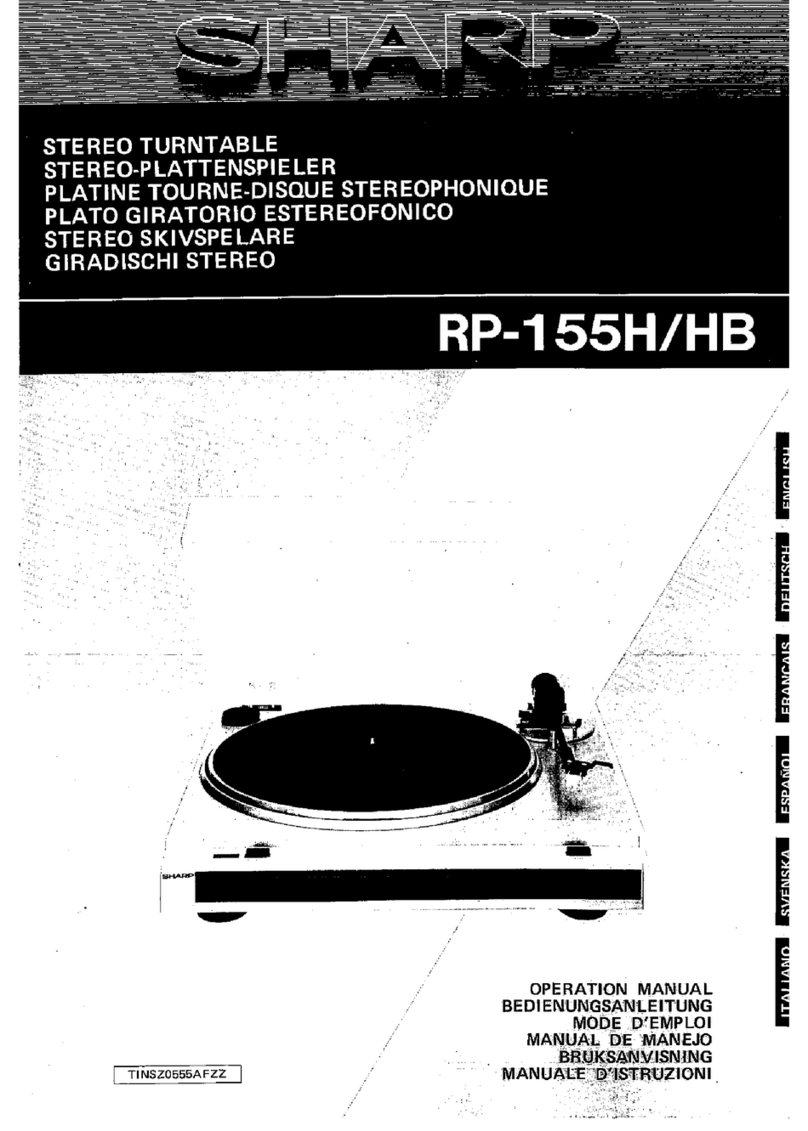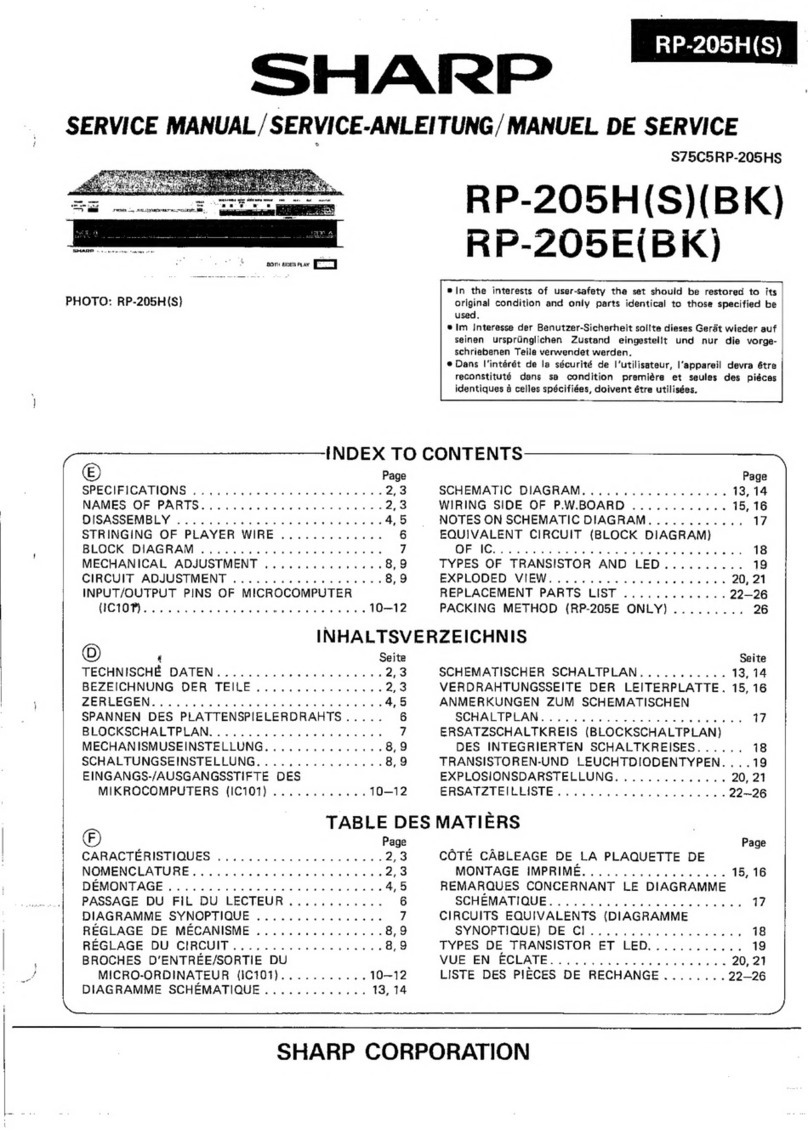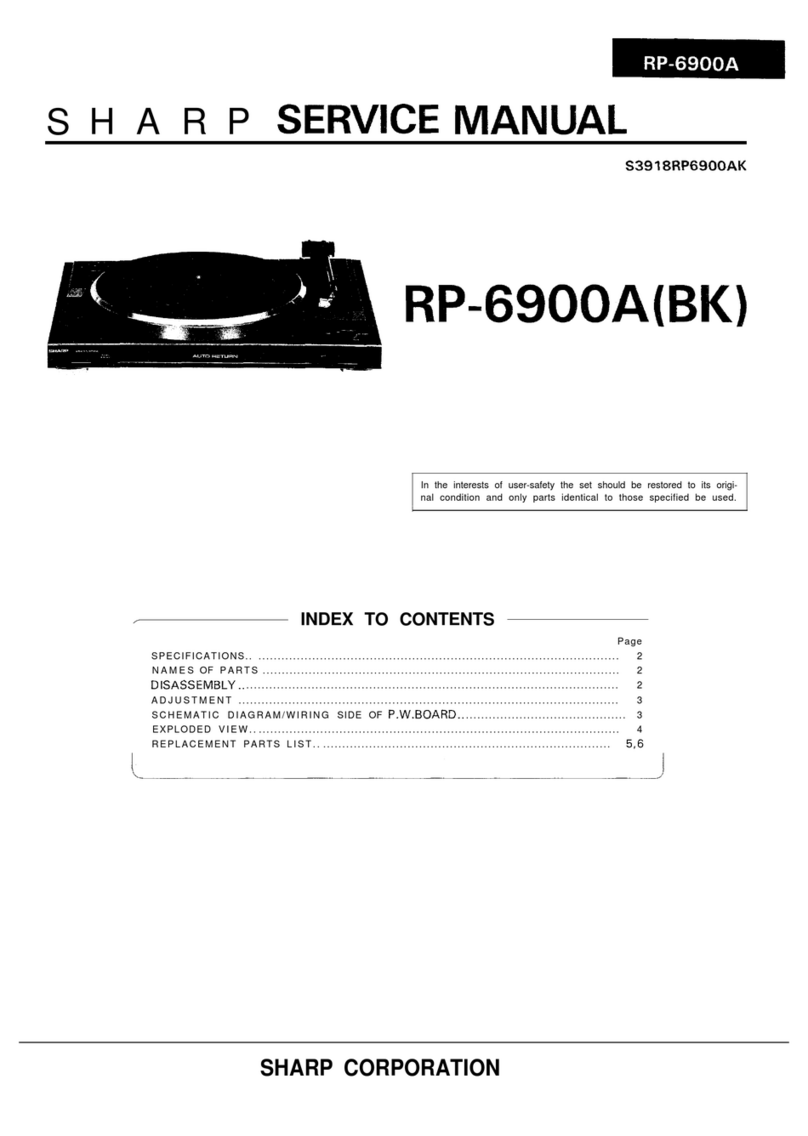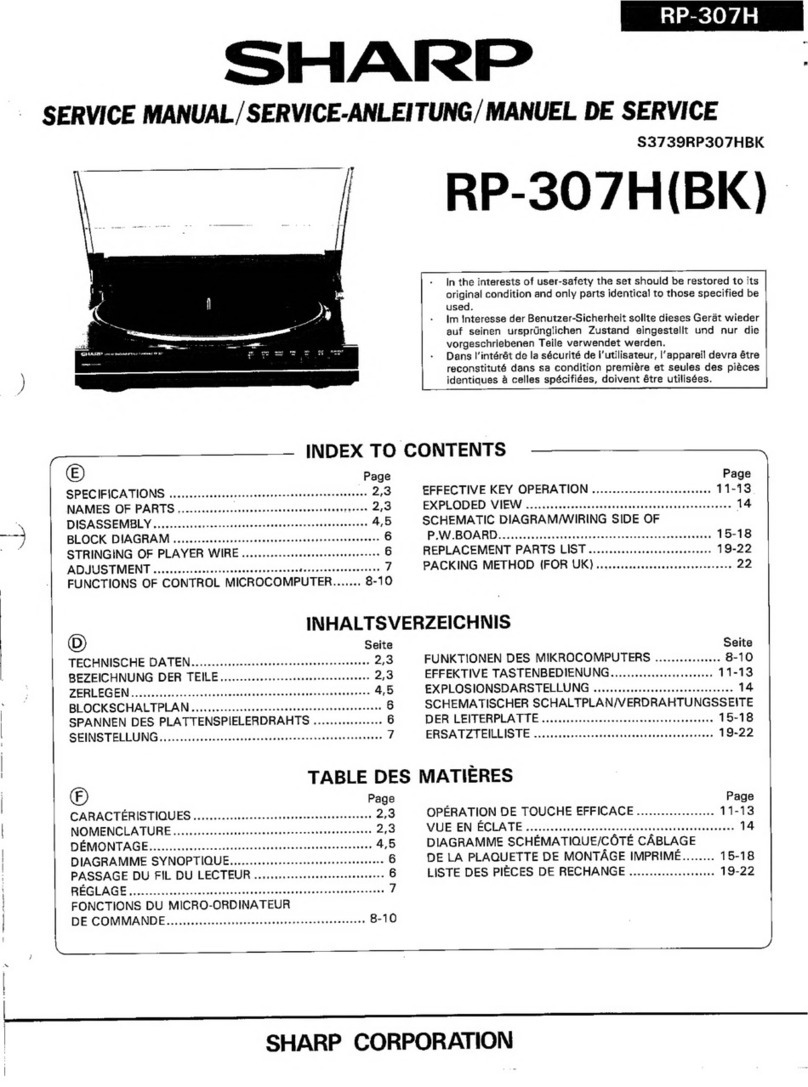
©
Tastan-Stouerteil
Wiedergabe,
Unterbrechung,
Tonarmlift,
Tonabnehmer-Vortauf/Riicktauf,
APSS-
Vortauf/APSS-Riicklauf,
beidseitige
Wie-
dergabe,
Wah!
der
Seite
A/B,
APMS(1)-
@)
APMS-Léschung,
Laden
der
Platten-
spielerzarge.
Synchronisierung-Steuerteil
Synchronisierte
Aufnahme:
Niederpegeli-
ges
Signal
am
Stift
des
Mikrocompu-
ters
Synchronisierte
Zwischenraume:
Nieder-
pegeliges
Signal
am
Stift
(6)
des
Mikro-
Sensorteil
SchlieBen
der
Plattenspielerzarge,
Ton-
arm-Ruheposition,
Abtastung,
APSS/
Schaliplattengré8e,
Tonarmposition.
komputers
Mikrocomputer
Anzeigeteil
Wiedergabe
der
Seite
A,
Wiedergabe
der
Seite
B,
beidseitige
Wiedergabe,
wieder-
holte
Wiedergabe,
APMS(1)~(7)
(Anzahl
Dampfungsteil
Dampfung:
Niederpegeliges
Signal
am
Stift
des
Mikrocomputers
Phonomotor-Steuerteil
Vorwartsdrehung:
Hochpegeliges
Signal
am
Stift
des
Mikrocomputers
der
Programme}.
Tonarm-Steuerteil
Vorwarts-/Riickwartsdrehung
des
Tonab-
nehmermotors,
Antrieb
des
Tonarm-
Tauchmagnets
fiir
Seite
A,
Antrieb
des
Tonarm-Tauchmagnets
fiir
Seite
B.
Riickwartidrehung:
Hochpegeliges
Signai
am
Stift
(21)
des
Mikrocomputers
Niedrige
Drehzahi:
Hochpegeliges
Signal
am
Stift
0)
des
Mikrocomputers
Hohe
Drehzaht:
Niederpegeliges
Sig-
nal
am
Stift
(20)
des
Mikrocomputers
—
|
SCHALTUNGSBESCHREIBUNG
(OBERBLICK
UBER
DEN
PLATTENSPIELER-
STEUERTEIL)
TASTEN-STEUERTEIL
Dieser
Teil
besteht
aus
17
Tasten.
Die
Tasten
kOnnen
nur
einzeln
gedriickt
werden,
und
ihre
Prellzeit
ist
auf
40
ms
begrenzt.
1.
2.
3.
Wiedergabe-/Unterbrechungstaste
Durch
Driicken
dieser
Taste
ist
es
mdglich,
mit
dem
Abspie-
len
einer
Schallplatte
zu
beginnen,
oder
das
Abspielen
zu
beenden,
wenn
die
Plattenspielerzarge
geschlossen
ist.
Wenn
diese
Taste
bei
gedffneter
Plattenspielerzarge
ge-
driickt
wird,
wird
die
Zarge
geschlossen
oder
das
Gerat
auf
Bereitschaft
fiir
Beginn
oder
Beendigung
der
automatischen
Aufnahme
eingestellt.
Tonarmilifttaste
Ermdglicht
das
Abheben
und
Absenken
des
Tonarms
beim
Abspielen
einer
Schallplatte,
jedoch
nicht
bei
Einstellung
des
Gerdates
auf
die
Stopp-Betriebsart.
Tonabnehmer-Vorlauftaste
Ermdglicht
Bewegung
des
Tonabnehmers
zum
gewunschten
Titel
auf
einer
Schallplatte
(Programme
nach
dem
gegen-
wartig
abgespielten).
Der
Tonabnehmer
bewegt
sich
bis
zum
Loslassen
der
Taste,
kommt
dann
zum
Stillstand
und
senkt
sich
auf
die
Schallplatte
ab,
wenn
die
Wiedergabe-/Unter-
brechungstaste
gedriickt
wird.
Die
Wiedergabe
beginnt
ab
dieser
Stelle.
Um
den
gerade
abgespielten
Musiktitel
zu
Uberspringen
und
das
nachste
Programm
wiederzugeben,
die
Tonabnehmer-
Vorlauftaste
wahrend
der
Wiedergabe
drucken.
Der
Tonab-
nehmer
(Nadelspitze)
wird
von
der
Schallplatte
abgehoben
und
zum
Anfang
des
nachsten
Programmes
bewegt,
wonach
die
Wiedergabe
automatisch
ab
dieser
Stelle
beginnt.
Wird
die
Tonabnehmer-Vorlauftaste
dabei
in
gedriickter
Stellung
gehalten,
erfolgt
der
APSS-Vorlauf
ab
der
Stelle,
an
der
die
Taste
losgelassen
wird,
und
der
Tonabnehmer
bewegt
sich
bis
zum
Anfang
des
gewiinschten
Titels,
wonach
die
Wieder-
gabe
automatisch
ab
dieser
Stelle
beginnt.
Wenn
die
Tonabnehmer-Vorlauftaste
bei
APMS-Betrieb
gedriickt
wird,
wird
der
Tonabnehmer
von
der
Schallplatte
abgehoben
und
bis
zum
Anfang
des
nachsten
Programmes
nach
vorn
bewegt,
wonach
die
Wiedergabe
ab
dieser
Stelle
beginnt.
—11-
RP-107H/117H
RP-107H/117H
.
Tonabnehmer-Riickiauftaste
Erméglicht
Bewegung
des
Tonabnehmers
zum
gewiinschten
Titel
auf
einer
Schallplatte
(Programme
vor
dem
gegenwéar-
tig
abgespielten).
Der
Tonabnehmer
bewegt
sich
bis
zum
Loslassen
der
Taste,
kommt
dann
zum
Stillstand
und
senkt
sich
auf
die
Schailplatte
ab,
wenn
die
Wiedergabe-/Unter-
brechungstaste
gedriickt
wird.
Die
Wiedergabe
beginnt
ab
dieser
Stelle.
Der
APSS-Ricklaufbetrieb
ist
der
gleiche
wie
der
APSS-
Vorlaufbetrieb,
mit
dem
einzigen
Unterschied,
da&
die
Richtung
beim
Auffinden
des
Anfangs
des
gewunschten
Programmes
unterschiedlich
ist.
Wenn
die
Tonabnehmer-Ricklauftaste
bei
APMS-Betrieb
gedriickt
wird,
wird
der
Tonabnehmer
von
der
Schaliplatte
abgehoben
und
bis
zum
Anfang
des
Vorhergehenden
Programmes
bewegt,
wonach
die
Wiedergabe
ab
dieser
Stelle
beginnt.
.
Taste
fiir
wiederholte
Wiedergabe
Ermdéglicht
die
wiederholte
Wiedergabe
der
Seite
A
oder
Seite
B.
Die
wiederholte
Wiedergabe
wird
bei
nochmaligem
Driicken
der
Taste
geldscht.
.
Taste
fiir
beidseitige
Wiedergabe
Erméglicht
die
Wiedergabe
der
Seite
A
(oder
Seite
8)
mit
anschlieRender
automatischer
Wiedergabe
der
Seite
B
(oder
der
Seite
A).
Die
beidseitige
Wiedergabe
wird
bei
nochmali-
gem
Driicken
der
Taste
geldscht.
.
Wahitaste
fiir
Seite
A/B
Wechselt
die
Wiedergabe
der
Seite
A
und
Seite
B.
Bei
diesem
Wechsel
bewegt
sich
der
Tonarm
zur
Einlaufposi-
tion,
Um
die
Riickseite
der
gerade
abgespielten
Schallplatte
wiederzugeben.
Drehzahlwahlitaste
Erméglicht
manuelle
Anderung
der
Drehzahi
fir
eine
Schallplatte.
.
APMS-Taste
Erméglicht
die
Wah!
der
Anzahl
von
Programmen,
die
bei
APMS-Betrieb
wiedergegeben
werden
sollen.
Der
APMS-
Betrieb
wird
bei
nochmaligem
Driicken
der
Taste
geldscht.
10.
APMS-LGschtaste
Ermodglicht
Léschung
der
fiir
APMS-Betrieb
voreingesteliten
Zustande.
11.
Schallplattenauflege-Taste
Ermoglicht
das
Offnen
oder
SchlieBen
der
Plattenspieler-
zarge,
selbst
wenn
die
Zarge
gerade
gedffnet
oder
geschlos-
sen
wird.
SENSORTEIL
1.
ad
Sensor
fiir
ge6ffnete/geschlossene
Plattenspielerzarge
Zwei
Skelettschalter
dienen
zum
Erkennen,
ob
die
Platten-
spielerzarge
gedffnet
oder
geschlossen
ist,
die
wie
folgt
funktionieren:
Bei
geschlossener
Zarge
schaltet
sich
der
Skelettschalter
SW205
ein
und
der
Skelettschalter
SW204
aus.
Bei
gedffneter
Zarge
schaltet
sich
der
Schalter
SW205
aus
und
der
Schalter
SW204
ein.
Tonarm-Ruhepositionssensor
Der
Photounterbrecher
erkennt,
da
sich
der
Tonarm
in
seiner
Ruheposition
befindet
(auf
der
rechten
Seite
fiir
Seite
A
und
auf der
linken
Seite
fiir
Seite
B).
.
Tonarm-Positionssensor
Wenn
sich
der
Tonarm
nicht
in
seiner
Ruheposition
befin-
det,
funktionieren
die
Zahnradtrommel
und
der
Photo-
unterbrecher
zusammen,
um
Impulse
zu
erzeugen,
die
erkennen
lassen,
wie
weit
der
Tonarm
von
der
Ruheposition
entfernt
ist.
©
Partie
de
commande
de
touche
Lecture,
retranchement,
mise
en
pile,
avance/recul
de
ja
cellule,
APSS
d’avance/
APSS
de
retour, lecture
des
deux
faces,
sélection
des
faces
A/B,
APMS
(1)
a2,
effacement
d'APMS,
chargement
du
chassis
du
tourne-disques.
Partie
de
commande
synchro
Enregistrement
synchro:
signal
de
niveau
bas
a
ta
broche(
$)du
micro-ordinateur.
Espacement
syachro:
Signai
de
niveau
bas
aia
broche(6)du
micro-ordinateur
Partie
du
senseur
Fermeture
du
chassis
du
tourne-disques,
Position
d’appui
du
bras,
pistage,
APSS/
Micro-ordinateur
taille
du
disque,
position
du
bras
"
a :
Partie
du
témoin
Réglage
silencieux:
Signal
de
niveau
bas
Lecture
de
la
face
A,
lecture
de
la
face
8,
a
la
broche
(23}
du
micro-ordinateur
tecture
des
deux
faces,
lecture
par
répéti-
Partie
de
régiage
silencioux
|
tion,
APMS(1)a(7){numéro
des
pro-
grammes)
Partie
de
commande
du
moteur
phono
Rotation
en
a
Signal
de
niveau
haut
Partie
de
commande
du
bras
Rotation
en
avant/inverse
du
moteur
de
la
cellule,
entrainement
du
solénoide
du
bras
de
ja
face
A,
entrainement
du
solé-
noide
du
bras
de
/a
face
B.
4
la
broche
(22)
du
micro-ordinateur
Rotation
inverse:
Signal
de
niveau
haut
4
ja
broche
(21)
du
micro-ordinateur
Grande
vitesse:
Signal
de
niveau
haut
a
la
broche
(20)
du
micro-ordinateur
Petite
vitesse:
Signal
de
niveau
bas
4
la
broche
(20)
du
micro-ordinateur
DESCRIPTION
DU
CIRCUIT
(DONNEES
GENERALES
DE LA
PARTIE
DE
COMMANDE
DE
LA
LECTURE)
PARTIE
DE
COMMANDE
TOUCHE
Cette
section
est
constituée
de
17
touches
et
chaque
touche
est
du
type
a
blocage
et
son
temps
de
battement
est
limité
a
40ms.
1.
Touche
de
lecture/retranchement
Permet
de
démarrer
la
lecture
d’un
disque
ou
de
|’arréter
pendant
la
lecture
--
elle
est
opérante
quand
le
chassis
du
tourne-disques
est
fermé.
Quand
le
chassis
du
tourne-disques
est
ouvert,
si
cette
touche
est
enfoncé,
le
chassis
du
tourne-disques
sera
fermé
ou
l'appareil
sera
prét
a
démarrer
l|'enregistrement
automa-
tique
ou
le
dégager.
Touche
de
mise
en
pile
Elle
permet
la
montée
de
mise
en
pile
ou
la
descente
de
mise
en
pile
du
bras
pendant
la
lecture
d’un
disque:
il
est
impossible
de
la
commander
quand
|’appareil
est
dans
le
mode
d’arrét.
.
Touche
d’avance
de
la
cellule
Elle
permet
de
dépiacer
la
cellule
vers
la
partie
choisie
du
disque
(vers
les
programmes
ultérieurs).
La
cellule
peut
se
dépiacer
jusqu’a
ce
que
cette
touche
soit
dégagée,
puis
aprés
avoir
marqué
un
arrét,
le
bras
descend
sur
le
disque
si
la
touche
de
lecture/retranchement
est
enfoncée.
La
lecture
commence
a
partir
de
ce
point.
Pour
sauter
un
morceau
musical
en
cours
d’écoute
et
écouter
le
programme
suivant,
enfoncer
la
touche
d’avance
de
la
cellule
pendant
fa
lecture.
La
cellule
(pointe
de
l’aiguille)
quitte
le
disque
et
se
porte
vers
le
début
du
programme
suivant
et
fa
lecture
reprend
automatiquement
a
ce
point.
Si,
a
ce
moment,
on
continue
d’enfoncer
la
touche
d’avance
de
la
celljule,
!’APSS
d’avance
fonctionne
a
Partir
du
point
ot
fe
doigt
a
été
retiré
et
déplace
la
cellule
vers
le
début
de
la
piste
qu’on
désire
écouter
et
démarre
automatiquement
la
lecture
a
partir
de
ce
point.
De
plus,
quand
la
touche
d’avance
de
la
cellule
est
enfoncée
pendant
l’opération
APMS,
la
cellule
se
léve
du
disque
et
saute
vers
l’avant
au
début
du
programme
suivant
et
com-
mence
la
fecture
4
ce
point.
.
Touche
de
retour
de
la
cellule
Ejle
permet
de
déplacer
la
cellule
vers
un
programme
choisi
du
disque
(vers
les
programmes
précédents).
La
cellule
peut
se‘
déplacer
jusqu’a
ce
que
la
touche
soit
dégagée,
et
aprés
avoir
marqué
un
arrét,
elle
descente
vers
la
surface
du
disque
si
la
touche
de
lecture/retranchement
est
enfoncée.
La
lecture
démarrera
a
ce
point.
L’opération
d’APSS
de
retour
est
identique
a
l’opération
APSS
d’avance
mentionnée
ci-dessus
—
a
la
seule
différence
que
la
direction
de
!’emplacement
du
début
du
programme
choisi
est
contraire.
De
plus,
quand
/a
touche
de
retour
de
la
cellule
est
enfon-
cée
pendant
l’opération
APMS,
la
cellule
se
léve
de
la
surface
du
disque
et
saute
en
arriére
au
début
du
pro-
gramme
précédent
et
commence
la
lecture
a
ce
point.
.
Touche
de
lecture
par
répétition
Elle
permet
de
faire
la
lecture
par
répétition
de
la
face
A
ou
de
la
face
B.
La
lecture
par
répétition
est
annulée
en
pous-
sant
cette
touche
de
nouveau.
.
Touche
de
lecture
des
deux
faces
Elle
permet
la
lecture
de
la
face
A
(ou
face
B)
automatique-
ment
suivie
de
celle
de
la
face
B
(ou
face
A).
La
lecture
des
deux
faces
est
annulée
en
poussant
cette
touche
de
nou-
veau.
.
Touche
de
sélection
des
faces
A/B
Change
la
lecture
de
la
face
A
et
celle
de
ta
face
B.
Par
ce
changement,
le
bras
se
déplace
vers
!a
position
d’entrée,
ce
qui
entraine
la
lecture
de
l'autre
face
du
disque
que
l’on
écoute.
Touche
du
sélecteur
de
vitesse
Permet
de
changer
manuellement
la
vitesse
d’un
disque.
.
Touche
APMS
Elle
permet
de
déterminer
le
nombre
de
programmes
qui
seront
effectuée
par
la
fonction
APMS.
L’opération
APMS
est
annulée
en
poussant
cette
touche
de
nouveau.
10.
Touche
d’effacement
APMS
Elle
permet
d’effacer
les
conditions
préréglées
pour
l’opéra-
tion
APMS.
11.
Touche
chargement
Elle
permet
d’ouvrir
ou
de
fermer
le
chassis
du
tourne-
disques:
c’est
possible
méme
quand
le
chassis
est
ouvert
ou
fermé.
PARTIE
DU
SENSEUR
1.
3.
~12—
Senseur
d’ouverture/fermeture
du
chassis
du
tourne-disques
Il
y
a
deux
commutateurs
découverts
qui
détectent
le
fait
que
le
chassis
est
ouvert
ou
fermé,
de
la
facon
suivante:
Quand
le
chassis
est
fermé,
le
commutateur
découvert
SW205
s’allume
tandis
que
!e
commutateur
découvert
SW204
se
coupe.
Quand
|e
chassis
est
ouvert,
le
commutateur
SW205
se:
coupe
tandis
que
le
commutateur
SW204
s‘allume.
.
Senseur
de
position
d’appui
du
bras
Le
photo-interrupteur
détecte
le
fait
que
le
bras
est
sur
sa
position
d’appui
(a
droite
pour
la
face
A
et
a
gauche
pour
la
face
B).
Senseur
de
position
du
bras
Quand
le
bras
n‘est
pas
sur
sa
position
d’appui,
le
tambour
a
pignon
et
le
photo-interrupteur
fonctionnent
ensemble
pour
produire
des
impulsions
qui
permettent
de
détecter
a
quel
endroit
le
bras
est
situé
a
partir
de
fa
position
d’appui.

